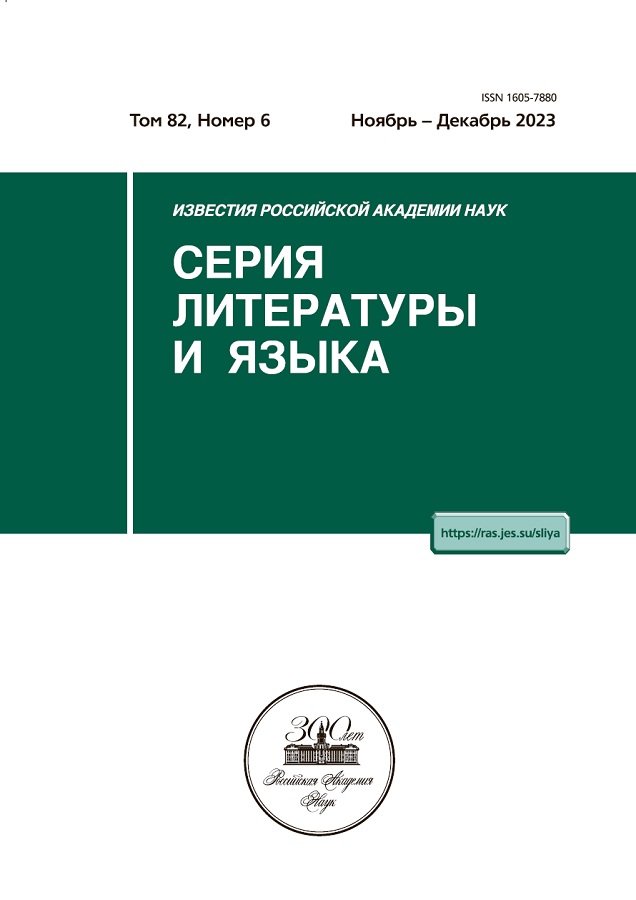About the Features of the Thai Poetic Meter Rai
- 作者: Sarkisov I.V.1
-
隶属关系:
- National Research University Higher School of Economics
- 期: 卷 82, 编号 6 (2023)
- 页面: 82-92
- 栏目: Articles
- URL: https://rjonco.com/1605-7880/article/view/656927
- DOI: https://doi.org/10.31857/S160578800029126-4
- ID: 656927
如何引用文章
详细
The article examines Thai poetic meter rai. Rai is one of 5 meters of Thai classical poetry. On the one hand, it was one of the most common Thai meters, because it was commonly used in epic poems. On the other hand, it is not only studied enough (like all other Thai meters and Thai metric in general), but very troubling for typological classification. While all 4 other Thai meters (at least in modern editions) are written with a division into graphical lines, which corresponds to the division into the poetic lines (like it must be in poetry in European and the most part of other languages), rai is written without such correspondence. Structural elements of rai (waks) are divided only by space (which is equivalent of comma or dot in Thai alphabet) and a graphical line can contain any number of waks. Stanzas (the number of waks in them also is not fixed) are divided as paragraphs. As a result, in terms of graphical representation rai looks more similar to prose than to poetry. According to this, T. Hudak classifies it not as a poetic meter, but as a rhymed prose. In this study I have analyzed rai statistically by counting the number of syllables in 555 waks of rai from one of the most famous examples of Thai poetry – epic poem ‘Lilit Phra Lo’. The results have shown that the most part of waks consist of 5 (47,8%–53,4%) or 6 (29,4%–32,9%) syllables. Also, the rhyme usually connects the last syllable of the wak with the third or the second syllable of the next one. This means that rai has a quite rigid syllabic and rhyme structure, which is typical for poetic meter and not for prose. According to this it should be classified not as rhymed prose, but as a syllabic poetic meter. It is important to notice that, being very different in terms of structure from all other 4 Thai meters, it is similar to Burmese traditional syllabic meter. Also, Burmese verses traditionally are written without graphical division of the text according to its division into poetic lines (how it is in rai and not in other Thai meters). These facts make it possible to provide a hypothesis that rai may be historically connected with Burmese poetry and this can explain its difference from other Thai meters.
作者简介
Ivan Sarkisov
National Research University Higher School of Economics20 Myasnitskaya Str., Moscow, 101000, Russia
参考
- Саркисов И.В. К вопросу о метрической классификации размеров тайской поэзии // Известия РАН. Серия литературы и языка. 2020. Т. 79. № 2. С. 39–49.
- Осипов Ю.М. Литературы Индокитая. Жанры, сюжеты, памятники. Л.: Издательство Ленинградского университета, 1980.
- Иванова В.А. Лирическая поэма “Камсуан сипратˮ (2-ая половина XVII в.) и становление жанра тайской литературы нират. М., 2018.
- Chitakasem М. Thai poetry: problems of translation // Lai Su Thai, Essays in Honour of E.H.S. Simmonds, ed. J.H.C.S. Davidsonю London, 1987, pp. 73–97.
- Hudak T.J. Meta-rhymes in classical Thai poetry // Siamese heritage trust. Volume 74. 1986. Pp. 38–61.
- Hudak T.J. Further observations on the Thai chan poetic conventions. 1992.
- Hudak T.J. Limericks and rhyme in Thai, Arizona State University. 2001.
- Cooke J.R. The Thai Khlong Poem: Description and Example // Journal of the American Oriental Society. 1980. Vol. 100. No. 4 (Oct.-Dec.). P. 421–437.
- Sarkisov I. Pri la klasifikado de la taja poetika metro khlong // ВАПросы языкознания: Мегасборник наностатей. Сб. ст. к юбилею В.А. Плунгяна / Ред. А.А. Кибрик, Кс.П. Семёнова, Д.В. Сичинава, С.Г. Татевосов, А.Ю. Урманчиева. М.: “Буки Ведиˮ, 2020. 684 с. ISBN 978-5-4465-2882-0. С. 136–140.
- Саркисов И.В. Рифма в метрических системах Юго-Восточной Азии // Известия Российской академии наук. Серия литературы и языка. 2021. T. 80. № 6. C. 89–103.
- Гаспаров М.Л. Очерк истории европейского стиха. Издание второе (дополненное). Москва, “Фортуна Лимитедˮ, 2003.
- Шапир М.И. “Versusˮ vs “prosaˮ: пространство-времяпоэтического текста // Philologica. 1995. Т. 2. № 3/4, С. 7–47.
- Саркисов И.В. Опыт изучения изучения метрических законов бирманской поэзии // Вестник РГГУ. Серия “Литературоведение. Языкознание. Культурологияˮ. 2021. С. 135–162.
- Бурман А.Д. Некоторые особенности бирманской рифмы // Страны и народы Востока, XI. М., 1971. С. 140–145.
- Златоверхова В.Г. Метрическая система бирманской классической поэзии // Проблемы восточного стихосложения. М., 1973. С. 142–160.
补充文件









